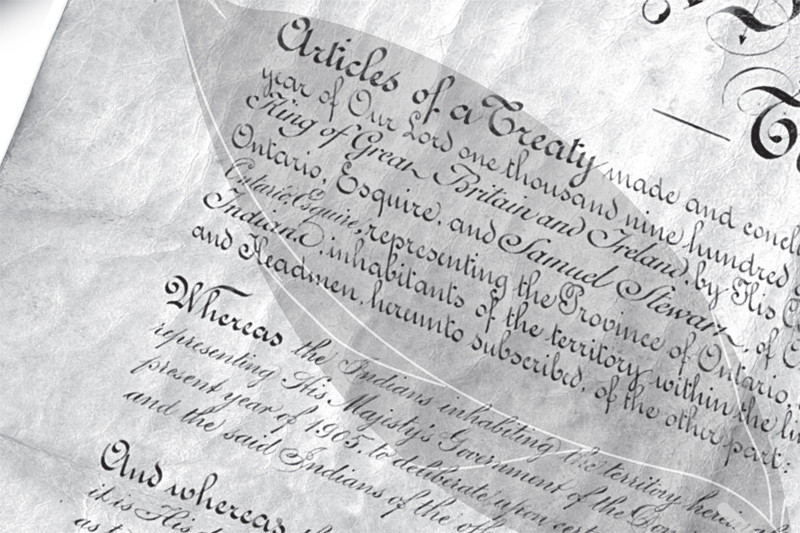Treaty Land Entitlement a slow process
Promises from two successive premiers remain unfulfilled for Manitoba’s First Nations
The English word “reconcile” essentially means to settle, harmonize and/or make compatible.
In this current era of First Nations-Crown relations, there can be no greater example of “reconciling” than Manitoba’s assumed jurisdiction and control over lands and natural resources within the province in relation to outstanding First Nations treaty land claims.
One case in point is the recent Treaty Land Entitlement (TLE) land selections made by the Brokenhead Ojibway Nation within the Whiteshell Provincial Park.
TLE refers to land owed to certain First Nations under the numbered treaties in Manitoba that were signed by the First Nations and the British Crown between 1871 and 1910.
Treaties One to 10 provided that the Crown would set aside a certain amount of land as reserve land based upon the populations of the “Indian bands” at the time of the original surveys for reserve lands. Not all Indian bands received their land entitlement as promised in the numbered treaties. This outstanding, guaranteed land is referred to as Treaty Land Entitlement.
On May 29, 1997, the Manitoba Treaty Land Entitlement Framework Agreement was signed between Canada, Manitoba and the Treaty Land Entitlement Committee of Manitoba Inc. on behalf of 21 Entitlement First Nations at Opaskwayak Cree Nation, near The Pas.
The Treaty Land Entitlement Framework Agreement outlines how the parties have agreed to fulfill the outstanding treaty land obligations in Manitoba arising from the numbered treaties. It sets out the principles, responsibilities and dispute resolution processes associated with the land selection and acquisition process to be undertaken by the Entitlement First Nations.
The Treaty Land Entitlement Framework Agreement provides for up to a total of 1,100,626 acres of land and $76 million toward the process of selecting and acquiring lands to be set apart as reserves for the Entitlement First Nations.
Of the 1,100,626 acres, 985,949 is the Crown land amount to be selected and 114,677 is the acreage amount to be purchased, or acquired, for those Entitlement First Nations who do not have sufficient amounts of Crown Land to select from within their traditional territory (such as the Brokenhead Ojibway Nation).
On May 29, 2010, the 13th anniversary of the signing of the Treaty Land Entitlement Framework Agreement occurred.
Since that time, 15 Entitlement First Nations have signed individual agreements under the umbrella Treaty Land Entitlement Framework Agreement, and are currently engaged in the land selection and acquisition process. As of August 2010, Canada has set aside a total of 426,893 acres of land as reserve for these 15 Entitlement First Nations.
In recognition of the slow pace of the treaty land conversion process, former Premier Gary Doer boldly announced Manitoba’s commitment to expedite the transfer of 1.1 million acres of Crown land over four years under the Treaty Land Entitlement Framework Agreement on June 28, 2007.
Since that time Greg Selinger has become premier. This past July, after meeting with the Treaty Land Entitlement Committee, Selinger committed to honouring and fulfilling his predecessor’s “bold” promise.
“ The settling of outstanding Treaty Land Entitlement claims is not only in the best interests of First Nations, it is in the best interests of Manitoba and Canada as a whole
While the Treaty Land Entitlement Committee and its Member First Nations welcome and embrace Selinger’s commitment, what’s needed now is action. This action must match the political commitments made by both premiers, and it must not be subjected to bureaucratic indifference and misguided interpretations.
Anything less would be unfortunate and disappointing.
The settling of outstanding Treaty Land Entitlement claims is not only in the best interests of First Nations, it is in the best interests of Manitoba and Canada as a whole.
This would only strengthen and enhance First Nations-Crown relations, as well as further the reconciliation process between First Nations and the Manitoba Government.
Ultimately, what’s at stake here is maintaining the “honour of the Crown.”
This legal and constitutional duty obligates all Canadian governments, including Manitoba, to act with integrity and honour in all its dealings. This includes settling TLE claims with the First Nations.
Chris Henderson is the executive director of the Treaty Land Entitlement Committee of Manitoba, Inc.
Published in Volume 65, Number 10 of The Uniter (November 4, 2010)







